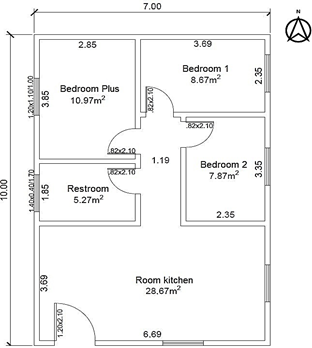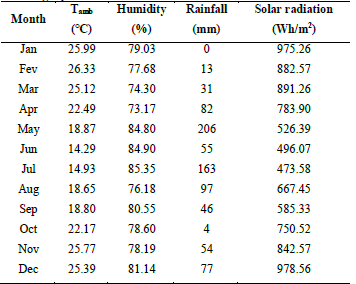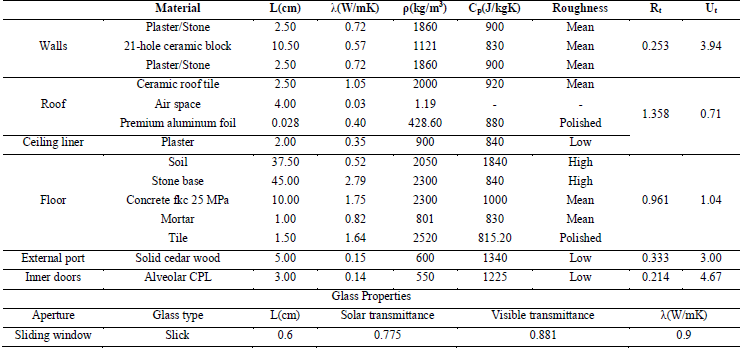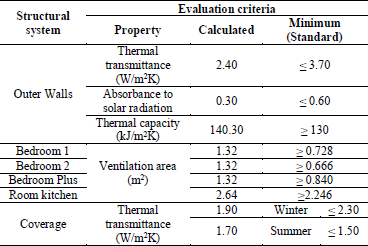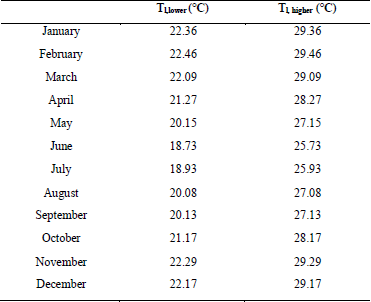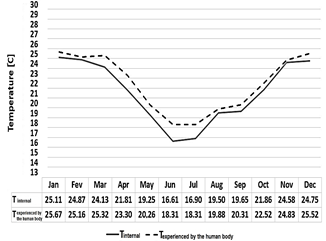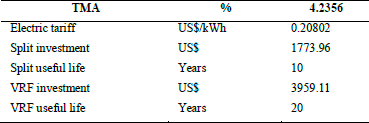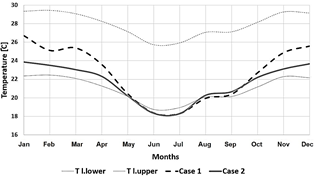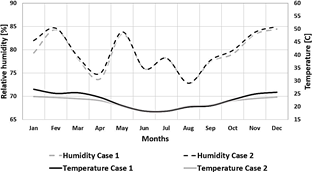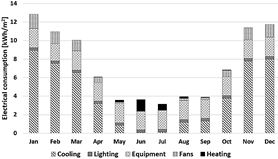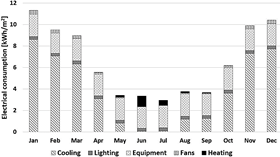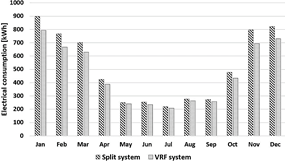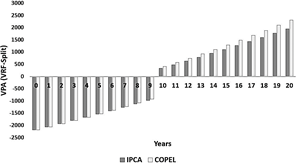1. Introduction
In Brazil, energy consumption in the residential sector represents about 29% of total consumption [1]. An increase of 1.8% per year is expected by 2026 [2], driven by the process of income improvement and household electronics growth, as well as increased by increasing access to the electricity grid in rural areas.
Electricity is the main source of energy in the residential sector with around 46%, with a projected growth of 3.9% per year until 2026 [2], such growth is strongly influenced by the increase in the use of air conditioning units. Studies by the Energy Research Company (EPE) show that the consumption of electricity by air conditioners in the residential sector has increased by 237% between 2005 and 2017, reaching 18.7 TWh [3].
The increase in air conditioning consumption in the residential sector is related to the increase in households’ purchasing power and the pursuit for thermal comfort (mental condition that expresses satisfaction with the surrounding thermal environment), to maintain feelings of well-being with the environment and avoid diseases such as allergies that affect people who spend more than 90% of their time indoors [4].
In view of the growing demand for energy associated with thermal comfort, alternatives have been sought for energy optimization in order to ensure that the indoor environment is comfortable during the occupation period, in order to postpone or avoid the use of artificial air conditioning [5].
The optimization of energy consumption was developed using the computer simulation tool of the thermal behavior of buildings: EnergyPlus [6], which is a program validated by American Society of Heating, Refrigerating and Air Conditioning Engineers (ASHRAE) Standard 140-2017 [7] and recommended by the Brazilian Technical Standards Association (ABNT) that allows the development of thermal and energy studies [6].
It is noteworthy that the west of Parana presents a considerable index of thermal discomfort mainly caused by heat and humidity [8]. Therefore, the application of natural ventilation systems or even an air conditioning system, is important, which guarantees the required thermal comfort conditions.
According to Paranaense Energy Company (COPEL) [9], the average consumption of electricity in Foz do Iguaçu is the highest in the state, averaging 223 kWh of energy per month, compared to 161 kWh per month of the Parana average. The main factor for the high average and the increase in the energy bill is attributed to the use of air conditioning during the spring and summer. In view of the facts mentioned, it is essential to propose alternatives to improve residential thermal comfort in Foz do Iguaçu, as well as in regions with similar climate characteristics.
Hence, the present research has as main objective to analyze the thermal comfort conditions of a single-family residence located in the city of Foz do Iguaçu, and to select an energy efficient and economically viable HVAC system. In order to achieve the general objective, the following specific objectives will be used: (i) Define and model the base case of the residence and assess the thermal performance according to ABNT NBR 15575 [10]; (ii) Assess the influence of selective ventilation on the model due to the thermal comfort parameters presented; (iii) Select an HVAC system, by comparing the energy consumption between a Split type system and a VRF type system; (iv) Carry out a technical and economic analysis of the proposed HVAC systems and select the best alternative.
Therefore, the contribution of this research is to offer a solution to improve the thermal comfort of users through the estimated thermal sensation inside the residence, with the objective of reducing energy consumption and the cost in money, in a region with high use artificial packaging for climate issues, and in regions with similar climate conditions.
The research is structured in 6 sections: introduction, state of the art, methodology applied in the research, proposed development, analysis and discussion of the results and finally the conclusions in the sixth section.
2. Literature review
This section presents a bibliographic survey on works related to the scopes under study that had application of thermoenergetic simulations using EnergyPlus. Projects to improve thermal comfort in constructed buildings are being developed (without the necessity of modifying the structure). Grings [11] made a comparison between computational results obtained through EnergyPlus and the experimental results of the thermal behavior of a conditioned and non-conditioned. Thus, they concluded that in order to have solid results, a detailed description of the loads is needed. According to a study carried out in Brazil by Matos et al., [12], using the adaptive approach that considers physical and psychological factors that interact in the thermal sensation [13], showed that the use of programmed selective ventilation promoted differences in temperature and humidity inside the house.
As for air conditioning systems, Zhou et al., [14], developed a programming module coupled to EnergyPlus for the simulation with VRF systems, for application in commercial buildings. The work compared the electric energy consumption of the VRF system with two other conventional air conditioning systems, known as the Variable Air Volume system (VAV) and chilled water system with fan-coil. The savings in electricity consumption expected with the VRF system reached 22.2% and 11.7% compared to the VAV and fan-coil systems respectively.
Grass [15] performed a comparison between VRF and residential Split systems in order to identify which system is the most energy efficient; the VRF type air conditioning system had the lowest power consumption. Compared to the Split air conditioning system, the VRF has a 25.6% lower consumption but is not satisfactory in terms of return on investment. Pozza [16], also proposed replacing the air-conditioning system by a reverse cycle Split-type residence with a VRF system, concluding that energy consumption decreased by 32.8%.
Regarding the Brazilian Technical Standard (NBR) 15575-1 building thermal performance standard, Santo et al., [17], points out that all limits specified by the standard are in function of the bioclimatic zone of the location in which the structure is inserted, disregarding internal factors of occupation and thermal gains, which could generate distorted results. In this work, NBR 15575-1 was used because it is the current standard regarding the thermal performance of buildings in Brazil.
3. Methodology
In this section, the proposed methodology for the development of the research will be addressed, which was divided into five stages, starting with the definition and modeling of the base case, going through the conditions of the simulation, until the economic analysis and discussion of the results.
Base case definite and modelling: The definition of the base case was carried out, where a single-family residence of prototype, techniques and common building materials in the region was chosen. Soon it was modeled, where the 3D model was created in the SketchUp 2017 program, based on the architectural plan considering the characteristics that define the residence, such as geometry, dimensions and composition. The definition of the thermal zones was carried out using the OpenStudio 2.8 plugin. The computer simulations were developed in the EnergyPlus program, where the input data (climate file, materials, occupancy pattern, lighting, equipment, air infiltration) were established, then the operating schedules (activity levels, hours of operation) were shaped (occupation of environments, artificial lighting schedule, equipment usage pattern). The evaluation of the thermal performance of the residence was carried out according to the NBR 15575 standard for housing buildings, the two normative procedures indicated, the simplified and the computer simulation, were adopted.
Comparison variables: The comparison variables that influence thermal comfort were defined, being: comfort temperature used to establish the limits of the comfort zone; the relative humidity within the environments to establish the ideal limits for the human organism; and real temperature perceived by the human body (thermal sensation), which is calculated from the wind speed and the operating temperature.
Definition of systems analyzed: The definition of the systems to be analyzed were carried out, where two arrangements were arranged: natural ventilation and HVAC systems. In selective ventilation, two cases were established: Case 1 considering the air infiltrations of the construction model and Case 2 with operable windows. In the HVAC systems, the Split and VRF systems were analyzed.
Economic analysis: The economic analysis was carried out for the electrical consumption of the residence, measuring the influence of the proposed HVAC systems, considering that the cost of electricity tariffs is not constant, two scenarios were established: 1st scenario based on COPEL’s tariff adjustments; 2nd scenario related to the evolution of Broad Consumer Price Index (IPCA) inflation. For both scenarios, calculations of economic indicators were made: net present value, accumulated present value, internal rate of return and discounted Payback.
Analysis and discussion or results: The analyzes and discussions of the results were carried out using tables, graphs and figures for the cases of selective ventilation presented, the HVAC systems, and economic analysis. From the results obtained, an energy efficient and economically viable HVAC system was selected.
4. Proposed development
In this section, the first four steps presented in the methodology were developed. In the development of the model, the construction of the 3D computational model, definition of the simulation parameters (input data, operating schedules) and thermal performance evaluation (NBR 15575) are presented. In the variables and systems analyzed, the definition of ventilation cases and HVAC systems is carried out, as well as the definition of comparison variables such as the parameters of comfort, relative humidity and real temperature perceived by the human body. In the economic analysis, the guidelines of the proposed scenarios and the variables to be analyzed are presented.
4.1. Model development
The base residence has a total area of 70 m2, with a ceiling height of 2.70 m; featuring three bedrooms, living room and kitchen and a bathroom Fig. 1. It is located in the city of Foz do Iguaçu, Brazil, oriented on the south-east and azimuth 180֯. The city is in climate zone 3A according to ASHRAE Standard 169-2013 Climate zone maps [18]. Table 1 shows the region’s climatic date [19].
For the computational simulation in the EnergyPlus program, the climate file of National Institute of Meteorology (INMET) station 86925 registered in the period of 2001-2010, was used [19]; the method applied for the generation of the climate archive is the Typical Meteorological Year, where the most significant months that occurred in the measured period are selected, thus generating a year composed of months of different years that provides dry and wet bulb temperature data, wind speed and direction, humidity, pressure. Seven input parameters were also set, detailed below.
Thermal Zones: All environments in the residence were considered as thermal zones according to Fig. 1. The five thermal zones consist of 70 heat exchange surfaces, with 36 surfaces divided between walls, floors, ceilings and roofs; 11 surfaces divided between windows and doors. There are still 23 surfaces between shutter registers and thermal bridges.
Materials: Building materials according to architectural design are shown in Table 2. The thermo-physical properties used in the simulation were obtained from [20-22]. Around the windows, the blinds were modeled with λ= 0.887 W/mK. Each of the thermal bridges of the architectural project is designed in the predefined location, with the material entered in the tab: material → not mass → λ= 4.005 W/mK [23]. Then the thermal bridges were selected in “OpenStudio/Inspector” where the properties of the surface were changed to “door”, the type of construction is assigned according to the thermal bridge (the “Frame and divider” field remained empty). The internal and external walls were considered to be white, due to the lower absorptivity and higher reflection index of the incident radiation [12].
Occupation: The occupancy standard was performed according to the RTQ-R parameters, which recommends that the minimum occupancy of dormitory rooms should be two people per room and the room should be used by all dormitory users [24]. A pattern of occupancy of the environments was modeled for weekdays (working days) and another for weekends and festive days. In order to simulate the heat generated by the occupants, heat generation values (total heat rate) were adopted for activities performed, being 108 W for a sitting/quiet person, 72 W sleeping person, 207 W person walking up to 0.9 m/s and 171 W person cooking [12,15,25].
Lighting: The lighting usage pattern for the residence was developed following the occupancy pattern proposed by Quality Technical Regulation for the Energy Efficiency Level of Residential Buildings (RQT-R) [24], one for weekdays and another for weekends.
Equipment: For homes with similar characteristics, the estimated average consumption of equipment was calculated using the method proposed by Brazilian Energy Efficiency Center in Buildings (CB3E) [26] and verified in RQT-R [24], being 1702.2 kWh/year. In the bathroom area, it should be noted that the convection currents generated by the temperature difference when the shower is turned on were not considered, because the simulation program does not model them [12].
Infiltrations: Air infiltrations in the conditioned rooms of the residence were 3 m3/h per meter of slot for all windows, excluding the bathroom window without sealing with 4.5 m3/h per meter of slot, for the interior doors and for the main door 1.8 m3/h and 6.5 m3/h per meter slit [27].
Thermal performance rating: Once the modeling of the residence has been carried out, the thermal performance evaluation for long-term environments established by the ABNT NBR 15575 standard [10] was carried out, which indicates two procedures: 1-simplified procedure, meets the requirements and criteria for the sealing and covers, according to NBR 15575-4 and NBR 15575-5; procedure 2- simulation, to verify compliance with the requirements and criteria established in NBR 15575-1.
In the simplified procedure, the calculations for the evaluation methods were made through equations presented in NBR 15220. According to NBR 15575-4, criterion 11.2.1- thermal transmittance of external walls, absorbance to solar radiation and criterion 11.2.2- thermal capacity of external walls. It was observed that the external walls of the residence satisfy the minimum levels of performance. Criterion 11.3.1- minimum ventilation area was applied to long-stay environments: kitchen room and bedrooms, where the effective area of openings Aa of free air circulation (operable windows) comply with the requirement of Aa 7% Ap area of floor. Table 3 presents the criteria and performance levels according to the simplified method.
The NBR 15575-5 criterion 11.2.1- thermal transmittance of coverage [10], establishes the criterion for calculating thermal transmittance for winter and summer. The resulting transmittance value of the coverage in the summer does not meet the minimum performance criterion Table 3, which is why the model must be reevaluated using the simulation method.
In the computer simulation procedure, starting from NBR 15575-1, the typical project days were established: June 21 for winter, and January 21, March 21, December 21 for summer, because of the different solar positions [28]. The analyzes exceeded the evaluation criteria with minimum performance for one of the typical summer days and minimum performance for the typical winter day.
In order to evaluate the effects of the user as a factor of influence in the classification of the performance levels, a simulation was proposed where the loads of occupation and thermal gains in the environment were considered and evaluated following the same norm. It was possible to determine a minimum performance for one of the typical days of summer and minimum performance for a typical day of winter.
The presence of occupants and internal equipment produces a significant gain in thermal load, which could modify the classification of the thermal performance level of the environment, but it must be considered that occupancy and use patterns are estimative and may change. While the internal temperature the average of the internal temperatures of the premises was realized, where a significant increase (up to 0.71 ℃) was observed in relation to the unloaded case on the typical summer day, and (up to 0.97 ℃) in relation to the unloaded case on a typical winter day. Thus, knowledge of the user’s profile and the characteristics of his occupation is inseparable from a thermally pleasing project [29].
4.2. System analyzed - Ventilation cases
For the analysis of the influence of ventilation on the thermal performance of the residence, two simulation cases were established: Case 1 considering only the air infiltrations of the construction model, air flows through four cracks around the windows, doors and ceiling; o Case 2 with a model of selective ventilation of operable windows with 50% opening, following occupancy patterns and climatic conditions [30].
The configuration of this system was carried out in EnergyPlus: ZoneAirflow → Zone Ventilation Window Stack Open Area, where it was configured to open windows for periods between 13:00h-21:00h on working days and from 9:00-21:00h on weekends and holidays during the months of January, February, March, November and December; in the months of April, May, August, September and October between 13:00-17:00 for working days and 9:00-17:00 for other days, in June and July the windows remain closed; the doors are considered closed throughout the year.
The two cases were then compared using the parameters of comfort temperature (Tl), relative humidity (UR), temperature perceived by the human body (Twc).
The temperature of comfort is not a constant, as it varies with the season and temperatures to which people are accustomed, as well as the physical and psychological factors that interact with thermal perception [31].
A study by National Electricity Conservation Program (PROCEL)/Eletrobrás and the Federal University of Santa Catarina (UFSC) using the adaptive thermal comfort model is presented by the Ministry of Environment (MMA) and the Projecting Energy Efficient Buildings program (ProjetEEE), showing the temperatures of the comfort zone for the city of Foz do Iguaçu Table 4, which were used as the limits for the comparison case [32].
The relative humidity of the air represents a meteorological variable that can affect the organism of all living beings [33]. Regulatory Standards (NR)-17 stipulates that relative humidity should not be less than 40% in environments with people [34]. The National Health Surveillance Agency (ANVISA) resolution n◦ 9, establishes that the ideal is to maintain the relative humidity indoors between 40% to 65% in summer and 35% to 65% in winter [35], these values were adopted as comparison limits.
To quantify the real temperature experienced by the human body (thermal sensation) inside the residence, a methodology was used that estimates heat loss in the human body at low temperatures and associates air temperature values with wind speed. This temperature was obtained through eq. (1), where wind speed m/s (Ws) and temperature operative ℃ (T) [36].
In thermal comfort analyzes, the interior temperatures (dry bulb temperature) of the premises are often used disregarding the Twc, this simplification presents unrealistic results due to the considerable difference between them as shown in Fig. 2, with up to 1.69 ℃ discrepancy.
4.3. System Analyzed - HVAC
Due to the great demand for air conditioning to supply the need for thermal comfort, we seek to choose the most efficient and economical system, through computer simulations for all rooms excluding the bathroom.
In the EnergyPlus software, the Split system was modeled in autozise, this approach is used to obtain a prior estimate of the required air conditioning loads [25], operating hours were configured according to the occupancy periods of each dependency, excluding if the bathroom was not considered due to the low level of occupancy.
The set-point on the thermostats was programmed to work when the internal temperature reaches the limits of the comfort zone Table 4, given the difficulty of predicting the temperature at which the occupants of the residence will use the devices, a temperature point of use was established, being 23 ℃ from October to March and 19 ℃ from April to September [28], a relative humidity control schedule was created to keep it between the indicated intervals during the periods of functioning of the system.
Therefore, devices with inverter and reverse technology (cooling/heating) available on the market were selected considering the load, performance coefficient (COP), air flow. The technical data extracted from the catalogs of the teams selected in Table 5 were entered in the category HVACTemplate → System → Unitary. To design the VRF system, the same operating schedules and thermostats were used as in the Split system, using the System: VRF autozise function. In these systems, the thermal load of the central (external) equipment is the maximum simultaneous load of the set of units supplied (indoor) [28], to ensure the correct dimensioning of the VRF system, the corrected capacity index (CCR) was taken into account and the combination rate (CR). From the commercial equipment chosen in Table 6, the available technical data were inserted in the category HVACTemplate → System → VRF.
4.4. Economic analysis
The project residence is located under COPEL’s guidelines, for subgroup B1 (residential) customers who fall under the conventional tariff modality, with tariff + taxes (ICMS and PIS/COFINS) of 0.79878 R$/kWh. Energy tariffs vary according to the country’s economic, political and climatic factors.
Typically at a rate higher than that of inflation [39], in view of this based on the history of COPEL’s tariff adjustments [40] and the inflation evolution IPCA [41], a geometric average of evolution was performed for both scenarios: in 1st scenario (COPEL) an increase rate of 7.31% per year was obtained, and for scenario 2nd (IPCA) the growth forecast is 6.09% per year. The minimum rate of attractiveness (TMA) used was calculated from the geometric average of savings data over the past ten years [42].
The investment costs for the Split and VRF systems (Table 7) correspond to the average price of equipment available on the market, these values were calculated with the current financing rates and correspond to the total price of all equipment for each of the systems. From these data, cash flows were developed for each of the proposed scenarios. The economic indicators used were the net present value (NPV), cumulative present value (CPV), internal rate of return (IRR) and payback discounted (PBD).
5. Results and discussions
In this section, the results obtained are presented, followed by their analysis and discussion, according to the preestablished methodology. It begins by presenting the results of the simulation of the ventilation cases and their performance in relation to thermal comfort. Then, the results of performance and energy consumption for the two HVAC-type systems are presented. Finally, the comparative of the modeled systems and the economic analysis are carried out.
5.1. Ventilation
When analyzing the data, the influence of ventilation with operable windows (Case 2), in the significant reduction in temperature is perceived. It is noteworthy that the greatest differences are obtained in the summer months (the highest temperature gradient 2.85 ℃ was reached in the month of January) where the window opening periods were more prolonged, causing greater wind movement within the residence due to local parameters, which increases the rate of evaporation on the skin surface and reinforces the feeling of cooling within the dependency [31].
As for thermal comfort, it is observed that in the summer, autumn and spring months, Cases 1 and 2 are within the comfort zone limits shown in Table 4, while winter months are outside the comfort zone limits as can be seen in Fig. 3, which demonstrates the need for heating in this period.
It should be noted that the values presented in Fig. 4 correspond to Twc calculated on the monthly averages obtained from the climate file, which leaves out the “extreme” days of the year, which in this case was calculated Twc: 35.4 ℃ for January 13th (hottest day of the year), and Twc: 5.74 ℃ for July 22 (coldest day of the year), values that are clearly outside the limits of the thermal comfort zone.
Regarding the relative humidity, it is noted that the differences are smaller Fig. 4, with greater influence in the summer months because of the selective ventilation schedules, but in all months of the year the humidity averages are above the stipulated limits, this demonstrates the difficulty of maintaining UR below 65% naturally.
The results presented for the studied ventilation cases show that Case 2 (50% aperture selective window ventilation model) selective ventilation has better performance than Case 1 (considering only the constructive model’s own air infiltrations), although there is a need for artificial cooling, heating and humidity control mechanisms to achieve the established thermal comfort parameters.
5.2. HVAC System
Considering Case 2 as a basis, a hybrid ventilation system was adopted, where the simulation for HVAC systems was performed according to literal B.2) from the previous section (the HVAC system will work when Selective Ventilation Case 2 not within the limits of the thermostat), the results obtained for both the Split system and the VRF system, are presented below.
Split System: The electric consumption of the residence obtained with the Split system is 6166.59 kWh per year (88.10 kWh/m2), where the highest consumption is registered in the summer months, reaching its peak in January with (12.84 kWh/m2) and the lowest in July (3.14 kWh/m2). The Fig. 5 shows the great influence of refrigeration on the total consumed, which is appropriate for the Foz do Iguaçu region. There is a greater participation of heating in the cold months of June and July.
VRF System: The electrical consumption of the residence obtained through the VRF system is 5542.94 kWh per year (79.18 kWh/m2), the peak consumption was reached in January with (11.34 kWh/m2), and the lowest in July with (2.97 kWh/m2). In Fig. 6 it can be seen that in the hot months the participation of the VRF air conditioning system (refrigeration, heating and fans) in the general consumption is much higher than the rest of the services.
5.3. Performance comparison of Split vs. VRF Systems
The performances referring to the Split and VRF systems, show a similar trend regarding the consumption of refrigeration, lighting, equipment, fans and heating Table 8. The VRF system achieved an annual energy saving in air conditioning of 14.76% compared to Split; in both cases the higher consumption is due to refrigeration and internal equipment, the VRF system in relation to the Split system had a decrease in heating of 21.77%, in cooling 4.24% and in ventilation 73.24%. In lighting and equipment consumption is the same in both cases, since they are loads independent of the system used.
In Fig. 7, it can be seen that the period of greatest difference between the systems occurs in the months of January to March and November to December, where the VRF system has less consumption due to the greater efficiency in partial loads when the system is not required to the maximum.
Thus, the frequency control of the compressor makes the air conditioner with variable refrigerant flow higher than the Split, which demonstrates the statement by Lee et al., [43] who found that the COP of the VRF system increases when the system works under these conditions, although the Split unitary system may have a higher COP than the VRF, in partial loads the VRF set can overcome this COP and present better performance.
The results show a reduction in total annual consumption of 10.11% with VRF system. Although the consumption reduction for a single family home is low in relation to studies carried out in residential buildings, it is justified that the longer the VRF system operates within the favorable partial load range, the greater the savings in electricity compared to others systems [14].
5.4. Economic analysis
From the data presented in section IV-C), the calculations of the variables mentioned were developed. The results obtained are presented in the Fig. 8, which shows the performance of the accumulated present value and the discounted Payback point.
For 1st scenario, COPEL, the calculations point to an average Return on Investment of 9.31 years, a Net Present Value of R$ 8884 and an average Internal Rate of Return of 11.87% per year. While for the 2nd scenario considering the Broad Consumer Price Index, IPCA, the average Return on Investment of 9.35 years, a Net Present Value of R$ 7 and an average Internal Rate of 10.91 % per year.
The results obtained from the evaluation of the economic analysis Table 9, show that the VRF system is economically more viable than the Split system in both scenarios (IRR ≥ TMA) which guarantees real return on investment, with 1st scenario being the most convenient with net present value and internal rate of return higher than 2nd scenario, in addition to the lower discounted Payback.
6. Conclusions
According to the analyses of the results of the model developed with the proposed methodology, it was possible to achieve the proposed objectives regarding computer simulation. The developed modeling allowed to simulate the parameters of occupation and use of the residence obtaining the estimate of the thermal comfort. The use of the ventilation techniques despite it brought improvements with variations in the levels of temperature and relative humidity, is not enough mainly in the winter months.
According to the analysis carried out, the system with the best performance for maintaining the residence within the parameters of thermal comfort is the VRF system, which presents annual energy saving to the air conditioning of 14.76% and saving in the total annual energy consumption of 10.11% about the Split system, being thus more economically attractive and still have a longer useful life.
Finally, as continuity of this research, it is suggested to carry through an analysis of the thermal performance modifying the orientation of implantation of the residence (changing the north), the type of construction materials (ecological tiles) and constructive structures that facilitate the inclusion of bioclimatic strategies adjusted for the a region. Thus, also lighting mechanisms such as tubular lighting that ensures well-distributed lighting in the environment, reducing electricity consumption and decreasing the thermal load [44,45]. These studies will contribute with the magnifying of the bibliographical base and to facilitate to the choices in the future research and applications.














